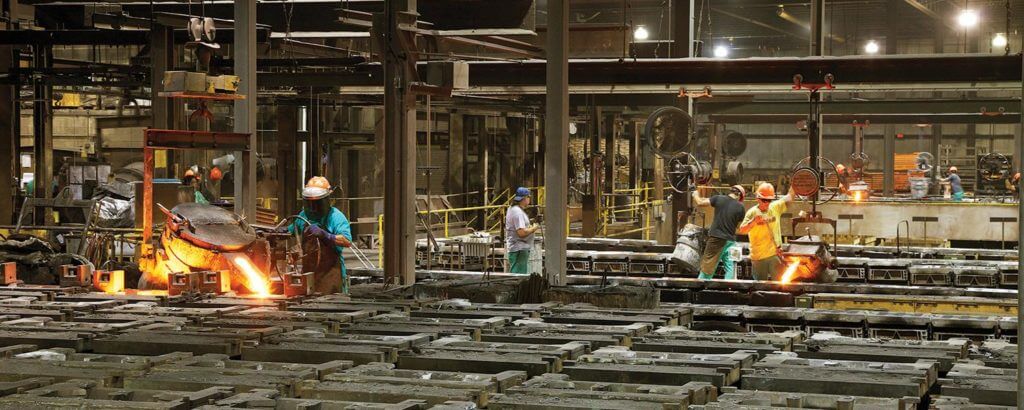

Investment and sand casting are reliable, cost-effective, quality manufacturing processes that allow for flexibility in budgets, timelines, and design.

Nearly any part configuration that can be made in another material can be produced using sand casting. Sand casting is more versatile with size and weight capabilities than investment casting. Parts are machined to achieve the exact tolerance and look for the finished part. Sand casting achieves net shapes within a quarter of an inch and has a rougher surface finish. Once cooled, the sand is removed and the parts proceed to the cleaning room for final cutting and grinding operations. Now the molten metal is poured into the mold. If the product has internal passage ways, a core is set in one mold half before the two mold halves are closed. Then the mold box is stripped and the mold halves are washed with a chemical agent to reduce mold/metal reaction. Sand mixed with a chemical bonding agent is dumped into the box, compacted and allowed to harden. The sand casting or sand molding process uses a wood or Polyurethane pattern set in a box to create the shape of the part. It is more costly than sand casting and requires longer lead times. While investment casting is ideal for highly complex designs – it can cast 1/8-inch walls at the thinnest and work with both ferrous and non-ferrous metals – investment casting does have weight and size limitations. Investment casting creates the same accurate part over and over, within thousands of an inch. Investment casting is preferred for its near net shape with a close tolerance to the final finished part and a naturally smooth finish. Once cooled, the ceramic outer layer is removed and the part proceeds to a cleaning room for final cutting and grinding. Then molten metal is poured in the shell. The wax is melted out of the shell and then heated in an oven to prepare for pouring. The wax impression is removed from the die, then dipped in a slurry to create a ceramic stucco shell. The investment casting, or lost wax process involves wax injected into an aluminum die block. The Differences between Investment Casting and Sand Casting They also are easily replicable when needed. The pattern used to make casting molds last through thousands of impressions and years of use, producing the exact same measurements every time. Our alloy casting table provides details on some of our more popular alloys. Stainless Foundry & Engineering pours more than 250 alloys for different applications. Foundries combine metals to create alloys with different chemical properties and varying levels of strength. Additionally, with high-grade material and the capability to cast walls as thin as 1/8 of an inch, foundries like Stainless Foundry & Engineering can produce complex parts without heavy duty stress concentrations.Ī single form cast part can be more structurally sound than a welded machined part because welded seams can weaken over time. Multiple castings can be made at once, and since they are in near net shape when removed from the mold, little to zero time is needed to machine the parts into their final dimensions and finished look.

When original equipment manufacturers (OEMs) convert a machined and welded part to single form casting, they often cut their production costs and timeline by nearly 50%. Metal casting is a more cost-effective option for mass producing complex parts because of time, material, and overhead savings alone. Compared to the alternatives, metal casting is more cost-effective and produces stronger parts.Ĭost-effective Production of Complex Parts Some non-cast parts are required to be made in multiple pieces and welded together. When castings are removed from their molds they are near net shape with minimal finishing work needed.Īlternatives to castings are fabrications, forgings or parts machined from bar stock. According to the American Foundry Society, highly engineered metal castings are part of 90 percent of durable goods. And since metal casting is one of the oldest industrial manufacturing processes, you’re never more than 10 feet away from a part that was created that way.įoundries mix custom combinations of elements, iron, aluminum, magnesium, zinc, steel, and copper to create different appearances, corrosion resistance, and strength characteristics. Pouring molten metal into a sand, metal, or ceramic mold is one of the most common ways to mass produce a complex part.


 0 kommentar(er)
0 kommentar(er)
